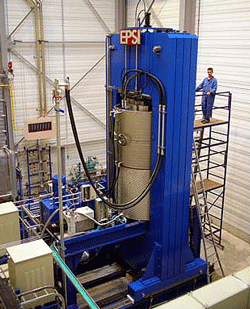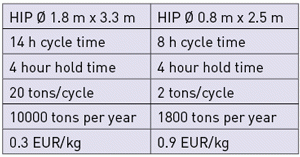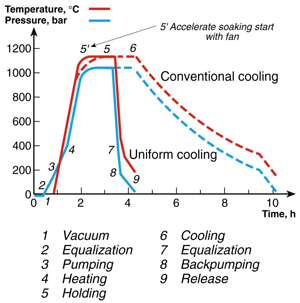Recent trends in Hot Isostatic Pressing (HIP) technology: Part 1 – Equipment
Hot Isostatic Pressing (HIP) involves the simultaneous application of high pressure (15,000 to 45,000 psi) and elevated temperature (up to 2500°C) in a specially constructed vessel. The pressure is usually applied with an inert gas such as argon, and so is ‘isostatic’. Under these conditions of heat and pressure internal pores or defects within a solid metal body collapse and diffusion bonding occurs at the interfaces. Encapsulated powder and sintered components can also be fully densified to give improved mechanical properties and a reduction in the scatter band of properties. In some cases, such as large powder metallurgy semi-products or large near-net shape PM components weighing several tonnes, HIPing is the only viable manufacturing option.
In a recent presentation Susan Davies, General Manager of Bodycote HIP Ltd in the UK [1], stated that HIP conditions are generally chosen so that the gas pressure at a specific temperature exceeds the yield stress of the material at that temperature. Under these conditions plastic flow occurs on a microscopic scale allowing the formation of isolated pores, which then collapse to allow direct contact of the two surfaces. This in turn allows bonding across the interface due to the diffusion of atoms in both directions. The closure of internal porosity in castings by HIP without affecting the microstructure has considerable benefits in improving the reliability of a casting, particularly when the castings are used in the aerospace, medical, automotive, offshore and marine sectors, stated Dr Davies. Examples of applications of HIP technology for powder metallurgy materials will be given in Part 2 of this review.
HIP systems
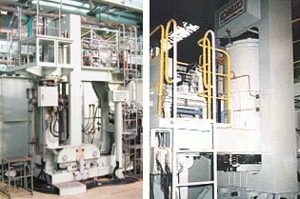
Fig. 2 Kobe Steel Ltd has developed HIP equipment
capable of operating commercially at temperatures
up to 2500°C and high pressure (1.0GPa)
A HIP system requires a pressure vessel, inert fluid (gas), means of pressurising the fluid (gas), and a heating system. The original hot isostatic press used a monolithic forged steel autoclave sealed by a threaded top closure through which the inert gas, argon, was pumped. The requirements for ever higher pressures and/or temperatures has seen the development of new designs of HIP systems including multi-wall forged, relatively thin-walled vessels surrounded by tight fitting forged steel rings, or steel wire wound. Two examples of commercial HIP equipment are shown in Fig. 1 and Fig. 2.

Fig. 3 The pressure vessel is the backbone of any
HIP system. (From presentation by A. Eklund, Avure
Technologies, at ‘Workshop on HIP Processing of
Materials for Aggressive Environments’, Derby, UK,
November 16, 2011)
In the steel wire wound system, for example, the radial forces are taken up by a forged steel cylinder pre-stressed with kilometers of high strength steel wire (Fig. 3). The axial forces are transferred through the two moving closures to the external frame which is also pre-stressed with the wire winding. Pressure is sealed within the vessel using Bridgman seals, metal-to-metal seals, single or double O-rings, or a combination of these. The pre-stressing causes the pressure vessel wall to remain in residual compression even at maximum operating temperature, eliminating tensile loads, and preventing crack propagation and brittle failure. Such a vessel has a calculated fatigue life of more than 20,000 cycles [2].
Fig. 4 shows the layout of the world’s largest ‘giga-HIP’ system built by Avure Technologies (Sweden) and installed at Metals Technology Ltd in Japan in February 2010. The system has a 2050mm inside working diameter by 4200mm tall, which can process parts at temperatures up to 1350°C and pressures of 1180 bar (17,000 psi). Avure Technologies believes that the next generation of HIP equipment will have working diameters of at least 3 meters and over 5 meters in height, and there are preliminary designs that would allow a 4000 mm working hot zone diameter.

Fig. 4 Layout of the world’s largest HIP system installed at Metals Technology Ltd in Japan to densify large castings and to produce PM parts for the aerospace, electronics and petroleum industries. The HIP system was produced by Avure Technologies, Sweden
The availability of such large HIP systems and the associated advances in cycle time reduction due to rapid cooling, has made the use of HIP as a powder consolidation process considerably cheaper in general terms than it was 20 years ago. An example of HIP process cost reduction is given in Fig. 5 [3]. The data in the figure assumes a HIP pressure of 1050 bar, and includes labour costs, utility and maintenance costs, and a five shift operation for 300 days/year.
The heart of the HIP system
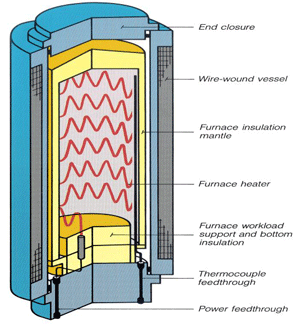
Fig. 6 Schematic of a modular plug-in wire wound
HIP vessel produced by Avure Technologies
with multiple heating zones and patented insulation
mantle design [2]
Avure Technologies believes that if the isostatic pressure vessel is the backbone of a HIP system, then the furnace is the heart (Fig. 6). The furnace consists of resistance heater elements arranged in multiple, independently controlled zones. The choice of furnace and heater element materials will depend on the material being HIPed and the temperature. For temperatures up to 1350°C Fe-Cr-Al alloys (Kanthal) can be used as heater elements. Molybdenum can be used in the temperature range 500 – 1600°C, and graphite for temperatures from 400 to 2200°C or higher. Graphite has the advantage of lower cost than refractory metals and has good strength and dimensional stability at high temperatures.
Graphite furnaces are used primarily for the HIPing of ceramic materials but also for HIPing of cemented carbides (WC-Co materials)
Properly operated and maintained the furnace will perform flawlessly for more than 10 years of continuous, demanding service.
Avure’s Uniform Rapid Cooling (URC) technology and quench furnaces are equipped with a forced convection system which circulates cooler gas through the work zone. Cooling rates of 100°C/min (above 800°C) and a heating rate of 30°C/min for a D=1.2 meter hot zone with a 2000kg load can be achieved without affecting the size of the hot zone significantly.
For smaller HIP vessels this temperature change rate, including the load, can be 300°C or even 400°C, depending on the vessel size [4]. This provides decreased cycle time, improved productivity, and can even combine HIP and heat treating. Fig. 7 shows a typical HIP cycle for an Avure Quintus® system with and without URC.
Containers for powders
Whilst solid metals such as castings or sintered parts can be loaded directly into the HIP furnace, blended metal or alloy powders are first filled into high quality steel containers which must be strong enough to maintain shape and dimensional control but be soft and malleable at the HIPing temperature. An example of a container filled with Alloy 625 powder is shown in Fig. 8 [5].

Fig. 8 (left) Pre-HIP filled can weighing 2050 kg with 1525 max OD; (centre) post-HIP 1345 mm maxOD; (right) heat treated and sonic machined HIPed part [5] (Courtesy Carpenter Technologies)
The standard container is between 2 and 3 mm thick. Containers are normally degassed at intermediate temperatures (ca. 300°C), sealed, preheated and then HIPed in a pressure vessel. In the case of PM superalloys, typical HIP conditions are a temperature of between 1100 and 1260°C and a pressure of 100 to 200 MPa, which is maintained for several hours with argon as the pressurising medium. The superalloy powders are consolidated to full density during HIPing by pressure assisted sintering. The container is removed by rough machining and/or pickling to reveal the near net-shape component. Compound products can also be produced by designing capsules with separate compartments for different powders or enclosing parts of solid material together with the powder.
Recent developments in computer modeling of the HIP process by the French consortium of SNECMA, Turbomeca, and Tecphy (now Aubert & Duval) and also VILS in Russia, have led to the production of complex near-net HIP shapes to very high dimensional precision with critical surfaces held to within 0.25mm.
Examples of HIPed powder metallurgy components and their areas of application will be given in Part 2 of this review.
References
[1] S. Davies. ‘HIPing – The Process and its Applications in Materials Manufacture’. Presentation at Workshop on HIP Processing of Materials for Aggressive Environments’, Derby, November 16, 2011.
[2] A. Eklund. ‘A HIP Future – The Latest Developments in HIP Technology’. Presentation at Workshop on HIP Processing of Materials for Aggressive Environments’, Derby, November 16, 2011.
[3] A. Riou, S. Olsson. ‘Trends and Applications in PM HIP Technology’. Paper in Proceed. Of International Conference on Hot Isostatic Pressing’, Kobe, Japan, April 2011, pp 7-11.
[4] M. Gärdin. ‘New Opportunities using the next generation HIP equipment’. . Paper in Proceed. Of International Conference on Hot Isostatic Pressing’, Kobe, Japan, April 2011, pp 169-172.
[5] L. Lherbier (Carpenter Technologies, USA), ‘An Alternative Fabrication Technology for Complex Shapes’. Presentation at Workshop on HIP Processing of Materials for Aggressive Environments’, Derby, November 16, 2011.
*Around 50% of these HIP installations were for R&D applications.
>>>> Part 2 – Powder based HIP products >>>>>
News | Articles | Market reviews | Search directory | Subscribe to e-newsletter



